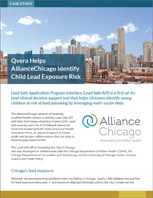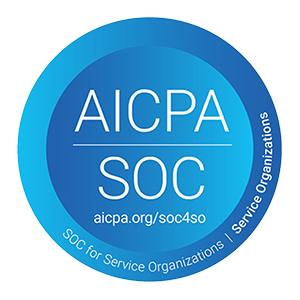QIE helps AllianceChicago identify and reduce child lead exposure risk
Lead Safe Application Program Interface (Lead Safe API) is a first-of-its-kind clinical decision support tool that helps clinicians identify young children at risk of lead poisoning by leveraging multi-sector data
The AllianceChicago network of federally qualified health centers is piloting Lead Safe API with help from Qvera Interface Engine (QIE). Lead Safe recently won the 2018 Milbank Memorial Fund and AcademyHealth State and Local Health Innovation Prize, an award designed to honor public and private collaborations that use data to improve population health.
The Lead Safe API is hosted by the City of Chicago and was developed in collaboration with the Chicago Department of Public Health (CDPH), the Chicago Department of Innovation and Technology and the University of Chicago Center for Data Science and Public Policy.
Chicago’s lead exposure
Although the lead poisoning incidence rates are falling in Chicago, nearly 2,000 children test positive for lead exposure every year — and exposure disproportionately affects the city’s under-served populations. Areas where higher blood lead levels are revealed in children under 3 directly correlate with areas identified as having Very Low Child Opportunity, a metric that includes low rates of literacy, graduation and employment.
According to the World Health Organization, lead poisoning is associated with lowered IQ, behavioral challenges, learning problems, anemia, hypertension, renal impairment, immunotoxicity and toxicity to the reproductive organs. All of these effects are believed to be irreversible.
And despite a wealth of data that confirms this public health crisis, most current lead initiatives remain reactive: Only after a child tests positive for lead exposure are lead sources identified or effects of exposure remediated.
“Decades of data on lead prevalence exist, but data silos impede its potential impact on addressing disparities that are perpetuated due to social determinants of health.”
Nivedita Mohanty, MD – Chief Research Officer – AllianceChicago
Aggregating data for prevention
The Lead Safe API uses characteristics about the patient to determine if they are at a higher risk for lead poisoning. This determination is based on a machine learning algorithm that considers many factors that directly and indirectly correlate with future lead poisoning.
The model behind Lead Safe API, originally developed by the Data Science for Social Good Program at the University of Chicago, includes clinical data, census data, open data on buildings, and data belonging to the CDPH Lead Program. Because all of this data is collected and stored separately, applying it can be difficult. One challenge was turning a large amount of information into a comprehensive, yet comprehensible, data set. Another is providing this data to physicians in a format they can use. This project led to a streamlined method of sharing data across sectors of health by using an API, which will also be made available to other healthcare providers in the future.
“Decades of data on lead prevalence exist, but data silos impede its potential impact on addressing disparities that are perpetuated due to social determinants of health,” says Nivedita Mohanty, M.D., AllianceChicago’s Chief Research Officer and Director of Evidence Based Practice.
CDPH worked with University of Chicago data scientists to develop and deploy a predictive algorithm to identify lead risk. AllianceChicago provided leadership on the design and implementation. AllianceChicago is also conducting the initial pilot within their health centers to make this information available to clinicians who work directly with families living in at-risk neighborhoods.
QIE brings data to the point of care
The AllianceChicago team built an easy to use assessment form in their EHR GE Centricity that uses Qvera Interface Engine (QIE) to instantly return a lead risk score when a patient’s address is entered or updated. Upon a single button click, QIE submits the query to the city’s predictive model. The resulting JSON message is translated into text that communicates the risk determination within the Centricity form. This will allow clinicians to provide education and intervention measures as necessary.
When a patient is determined to have an elevated risk, the EHR alerts AllianceChicago healthcare providers to discuss risk with the patient, ensure blood lead testing is done on time, and refer CDPH lead inspectors to visit the address and perform a free inspection to detect the presence of lead. If the household is found to have lead present, it is possible to then intervene and develop a remediation plan before any lead poisoning occurs.
“If we know where a child lives and that there’s a high lead prevalence in those geographies, we can communicate to the provider and have them request a lead inspection to reduce risk before exposure,” Mohanty explains.
The AllianceChicago pilot program will begin by prioritizing pregnant women and infants in their first year
Small steps toward big change
The AllianceChicago pilot program will begin by prioritizing pregnant women and infants in their first year. It will start with four health centers, to make sure the city can fulfill inspection requests before increasing its reach.
“We hope to scale this to much larger health centers,” Mohanty says. “Any investment you make in early childhood development has huge returns for society at large. To be able to ensure kids are optimally positioned to succeed has so many benefits, and addressing the lead issue is a critical part of that. We are so grateful to Qvera for making this stage of the implementation possible.”
Produced by Qvera in partnership with: AllianceChicago, Chicago Department of Public Health (CDPH), Chicago Department of Innovation & Technology, University of Chicago Center for Data Science and Public Policy | © 2018



